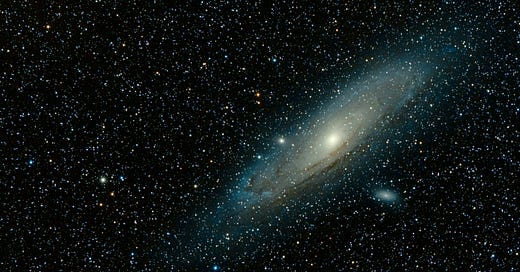Scientists Refine Earth's Location in the Universe to A Massive Cosmic Void
Earth may not be in the center of the Universe, but it is in the middle of a massive cosmic void
Hiya!
Mathematician and astronomer Nicolaus Copernicus shocked the world in the 16th century when he announced that Earth is not the center of the universe. While such claims were considered blasphemous at the time, research since then has only confirmed that Earth really isn’t all that special in the grand scheme of things.
Obviously, it’s invaluable to us as a species, yet research suggests that roughly 10 percent of the septillion-or-so stars in our universe have an orbiting planet similar to Earth.
Still, recent scientific advancements are renewing the fluster Copernicus caused hundreds of years ago by announcing that Earth may not be in the center of the universe, but it does appear to be in the middle of a massive cosmic void.
The Standard Model of Cosmology
Before I get to the fun bit, it’ll be helpful to review a couple of things, like the standard model of cosmology.
Isaac Newton argued in his 1687 book Mathematical Principles of Natural Philosophy that the motions of planets and stars could be explained by a universal gravitational law — known as the law of universal gravitation. Modern scientists refer to Albert Einstein’s 1915 theory of general relativity to explain gravity today, but Newton’s idea is similar to how scientists think matter in the universe is distributed.
The cosmological principle is the idea the spatial distribution of matter in the universe should be both homogeneous and isotropic. In other words, the universe should appear the same everywhere, no matter where you are within it or the direction you look. The cosmological principle is now baked into the standard model of cosmology, also known as the ΛCDM Model of Cosmology.
The standard model doesn’t suggest matter in the universe is entirely smooth, like cream cheese, but more like crunchy peanut butter, where some clumps of matter exist, but they aren’t the norm.
The model also includes the notoriously elusive dark matter and dark energy, which are thought to make up most (95 percent) of the universe — meaning everything we see only accounts for only about 5 percent.
We can’t see dark matter or energy (hence “dark”), but scientists can measure their influence on things we can see. For instance, dark matter appears to interact gravitationally with visible matter, and it’s thought that dark energy is responsible for the universe’s expansion.
The standard model explains critical features of the cosmos perfectly to our liking, but that doesn’t mean it’s perfect.
Two Issues with the Standard Model
Keep reading with a 7-day free trial
Subscribe to Curious Adventure to keep reading this post and get 7 days of free access to the full post archives.



